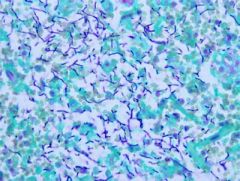![]()
![]()
![]()
Use LEFT and RIGHT arrow keys to navigate between flashcards;
Use UP and DOWN arrow keys to flip the card;
H to show hint;
A reads text to speech;
29 Cards in this Set
- Front
- Back
|
What is the causative agent of swine dysentery? |
Brachyspira hyodysenteriae |
|
|
What sort of bacterium is Brachyspira hyodystenteriae? |
Slender, helical, oxygen tolerant but anaerobic Beta-haemolytic, gram negative, motile |
|
|
Which features of Brachyspira hyodysenteriae are required for pathogenicity? |
The flagellum The haemolysins tlyA, tlyB, tlyC. |
|
|
When is the main time that pigs are at risk for swine dysentery? |
After weaning, when they go into the finishing sheds. |
|
|
Where does Brachyspira hyodystenteriae multiply? |
Goblet cells of the colonic crypts Spreads to the enterocytes |
|
|
How does Brachyspira hyodysenteriae cause tissue damage? |
Haemolysin |
|
|
Where and what is the pathology in swine dysentery? |
Large intestine Inflammation, necrosis, excessive mucus production, varying degrees of haemorrhage The intestinal folds are usually thickened |
|
|
What sort of diarrhoea is seen in swine dysentery? |
Grey-black, sometimes watery, may contain mucus and necrotic material |
|
|
Of which disease is razor back a feature? |
Swine dysentery |
|
|
Why is direct microscopy of B hyodysenteriae cases not straightforward? |
B innocens is much less haemolytic and does not show intensification P pilosicoli is mildly haemolytic, causes porcine intestinal spirochaetosis |
|
|
Why is PCR not necessarily the answer for confirming swine dysentery? |
There used to be a gene specific to innocens, that is now found in B hyodysenteriae |
|
|
What is the causative agent of porcine intestinal spirochaetosis? |
Brachyspira pilosicoli |
|
|
What sort of bacillus is Bacillus anthracis? |
Gram positive, large, endospore-forming rods |
|
|
What does oxygen do to Bacillus anthracis? |
Induces formation of spores from the rods (thus in the microaerophilic intestine, it turns back into the vegetative form) |
|
|
In which 3 ways can one acquire anthrax? |
Ingestion Inhalation Biting insects |
|
|
Which group of animals are the most susceptible to anthrax? |
Cattle, sheep, goats |
|
|
What are the 4 virulence factors for anthrax? |
Capsule Toxins: Oedema toxin (adenylate cyclase) Lethal toxin (metalloprotease) Protective antigen |
|
|
What are the 3 forms that anthrax infection can take in man? |
Skin form pulmonary form intestinal form |
|
|
Which 2 forms can anthrax infection of pigs assume? |
subacute (lymphoma of pharynx, regional lymphadenitis intestinal |
|
|
What do you do with a cadaver if you take anthrax? |
Do a blood smear from a superficial vein Stain with polychrome methylene blue |
|
|
What does anthrax look like with McFadyen's stain? |

|
|
|
What sort of bacteria are enteropathogenic clostridia? |
Large, gram positive rods Anaerobic and sporulating |
|
|
What are the common clinical findings of C perfringens enterotoxaemias? |
Severe enteritis Dysentery Toxaemia Rapid death |
|
|
Which type of C perfringens causes food poisoning in humans, and enterotoxaemia with jaundice in lambs? |
Type A |
|
|
What does C perfringens type B cause? |
Lamb dysentery |
|
|
What does C perfringens type C cause? |
Haemorrhagic enteritis of pigs, lambs, calves and foals Struck Nectrotic enteritis of chickens |
|
|
Which C perfringens strain causes pulpy kidney? |
Type D |
|
|
Which Clostridia causes Braxy? |
C. septicum |
|
|
What is braxy? When is it likely to occur? |
Haemorrhagic and necrotising abomasitis of sheep and calves Occurs in spring, when animals are eating frost-damaged food |

